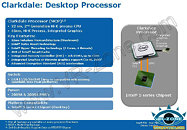- Joined
- Oct 9, 2007
- Messages
- 47,684 (7.42/day)
- Location
- Dublin, Ireland
| System Name | RBMK-1000 |
|---|---|
| Processor | AMD Ryzen 7 5700G |
| Motherboard | Gigabyte B550 AORUS Elite V2 |
| Cooling | DeepCool Gammax L240 V2 |
| Memory | 2x 16GB DDR4-3200 |
| Video Card(s) | Galax RTX 4070 Ti EX |
| Storage | Samsung 990 1TB |
| Display(s) | BenQ 1440p 60 Hz 27-inch |
| Case | Corsair Carbide 100R |
| Audio Device(s) | ASUS SupremeFX S1220A |
| Power Supply | Cooler Master MWE Gold 650W |
| Mouse | ASUS ROG Strix Impact |
| Keyboard | Gamdias Hermes E2 |
| Software | Windows 11 Pro |
On the course of coming up with mainstream derivatives of the Nehalem architecture, for Intel, there seems to be a big deal of uncertainty surrounding the dual-core parts. Havendale (desktop) and Auburndale (notebook) were stated by initial company road-maps as the company's dual-core chips. Later, news emerged of Intel reportedly scrapping both chips to find a 32 nm replacement in another chip codenamed Arrandale. In the latest company-slide exposé by VR-Zone, details emerge of yet another iteration to Intel's plans: Clarkdale. Correct spelling is Clarkdale and Arrandale by the way (not Clarksdale or Arandale).
While it is unclear at this point, if this chip, like the Arrandale (32 nm CPU + 32 nm IGP), is built to be deployed on both desktop and mobile platforms, the reason behind its development gains clarity. The Ibex-Peak platform design by Intel, be it dual-core or quad-core, consists of a standard multi-chip module (MCM)-based design, where two dice populate a package: the central processor, and the northbridge. The design gives the company flexibility by introducing a degree of modularity. After scrapping plans of a full-on processor built on the 45 nm high-K manufacturing process, Intel seems to have realised that its foundries won't be able to cater to many designs based on the 32 nm process initially, at once. Taking advantage of the MCM design, Intel is working on this new chip: Clarkdale, which consists of the processor die built on the 32 nm second-generation high-K process, with the northbridge being built on the existing 45 nm process. This design helps evade the manufacturing constraints Intel might have initially. The northbridge die will feature an integrated graphics processor that connects to its output using the flexible-display interface. With this, Intel is looking to bring in immediate and cost-cutting to the extant feasible.

View at TechPowerUp Main Site
While it is unclear at this point, if this chip, like the Arrandale (32 nm CPU + 32 nm IGP), is built to be deployed on both desktop and mobile platforms, the reason behind its development gains clarity. The Ibex-Peak platform design by Intel, be it dual-core or quad-core, consists of a standard multi-chip module (MCM)-based design, where two dice populate a package: the central processor, and the northbridge. The design gives the company flexibility by introducing a degree of modularity. After scrapping plans of a full-on processor built on the 45 nm high-K manufacturing process, Intel seems to have realised that its foundries won't be able to cater to many designs based on the 32 nm process initially, at once. Taking advantage of the MCM design, Intel is working on this new chip: Clarkdale, which consists of the processor die built on the 32 nm second-generation high-K process, with the northbridge being built on the existing 45 nm process. This design helps evade the manufacturing constraints Intel might have initially. The northbridge die will feature an integrated graphics processor that connects to its output using the flexible-display interface. With this, Intel is looking to bring in immediate and cost-cutting to the extant feasible.

View at TechPowerUp Main Site
Last edited by a moderator:

